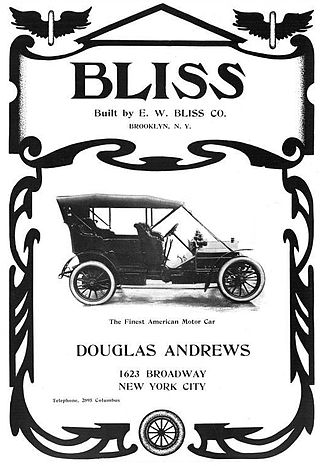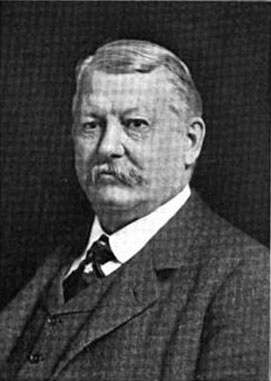The White Motor Company was an American automobile, truck, bus and agricultural tractor manufacturer from 1900 until 1980. The company also produced bicycles, roller skates, automatic lathes, and sewing machines. Before World War II, the company was based in Cleveland, Ohio. White Diesel Engine Division in Springfield, Ohio, manufactured diesel engine generators, which powered U.S. military equipment and infrastructure, namely Army Nike and Air Force Bomarc launch complexes, and other guided missile installations and proving grounds, sections of SAGE and DEW Line stations, radars, Combat Direction Centers and other ground facilities of the U.S. aerospace defense ring, such as the Texas Towers.

Eliphalet Remington was an American engineer who founded what would become known as Remington Arms. Originally the company was known as E. Remington followed by E. Remington & Son and then E. Remington and Sons.

Stoddard-Dayton was a high quality car manufactured by Dayton Motor Car Company in Dayton, Ohio, US, between 1905 and 1913. John W. Stoddard and his son Charles G. Stoddard were the principals in the company.
The Timken Company is a global manufacturer of bearings and power transmission products. Timken operates from 42 countries.

John Williams Stoddard was an American manufacturer of agricultural implements and automobile pioneer. He was a cousin of General William Tecumseh Sherman.

The Computing-Tabulating-Recording Company (CTR) was a holding company of manufacturers of record-keeping and measuring systems; it was subsequently known as IBM.

Single Center Spring Buggy Company was an American carriage and automobile manufacturer based in Evansville, Indiana. The Single Center factory manufactured the Zentmobile, Zent, Windsor, Worth, Single Center, Evansville, Simplicity and Traveler automobiles from 1903 to 1910.
Carpenter Technology Corporation develops, manufactures, and distributes stainless steels and corrosion-resistant alloys. In fiscal year 2018, the company's revenues were derived from the aerospace and defense industry (55%), the industrial and consumer industry (17%), the medical industry (8%), the transportation industry (7%), the energy industry (7%), and the distribution industry (6%). The company's products are used in landing gear, shaft collars, safety wires, electricity generation products, intervertebral disc arthroplasty, and engine valves and weldings.
Frank McDowell Leavitt (1856–1928) was an American engineer and inventor. Leavitt devised one of the earliest machines for manufacturing tin cans and later invented the Bliss-Leavitt torpedo, the chief torpedo used by United States Navy in World War I. Leavitt was part of an emerging cadre of American engineers whose design feats were putting United States manufacturing might on the map at the dawn of the twentieth century.

The Bliss automobile was manufactured by the E. W. Bliss Company of Brooklyn, New York, in 1906. The company was founded in 1867 and for a short duration, diversified into automobile manufacturing.

Eliphalet Williams Bliss was an American manufacturer and inventor who established the E. W. Bliss Company of Brooklyn, New York. His company supplied the US Navy with Whitehead and Bliss-Leavitt torpedoes, as well as projectiles for its naval guns during the Spanish–American War, World War I and World War II.

The Bliss-Leavitt torpedo was a torpedo designed by Frank McDowell Leavitt and manufactured by the E. W. Bliss Company of Brooklyn, New York. It was put into service by the United States Navy in 1904 and variants of the design would remain in its inventory until the end of World War II.
The Whitehead Mark 1 torpedo was the first Whitehead torpedo adopted by the United States Navy for use in an anti-surface ship role after the E. W. Bliss Company of Brooklyn, New York secured manufacturing rights in 1892. The US Navy made an initial acquisition of 100 Mark 1s, which, by the time they entered American service, were faster, had longer range and carried a larger warhead than Robert Whitehead's earlier models.
The Whitehead Mark 2C torpedo, also designated Torpedo Type C was a Whitehead torpedo adopted by the United States Navy for use in an anti-surface ship role after the E. W. Bliss Company of Brooklyn, New York secured manufacturing rights in 1892. It was probably based on the Whitehead Mark 1B, rather than a modification of the Whitehead Mark 2.

The Whitehead Mark 3 torpedo was a Whitehead torpedo adopted by the United States Navy for use in an anti-surface ship role after the E. W. Bliss Company of Brooklyn, New York secured manufacturing rights in 1892.
The Bliss-Leavitt Mark 1 torpedo was a Bliss-Leavitt torpedo adopted by the United States Navy for use in an anti-surface ship role after the E. W. Bliss Company of Brooklyn, New York, which had been building Whitehead torpedoes for the US Navy, began designing and manufacturing their own torpedoes in 1904.
The Bliss-Leavitt Mark 2 torpedo was a Bliss-Leavitt torpedo adopted by the United States Navy for use in an anti-surface ship role after the E. W. Bliss Company of Brooklyn, New York, which had been building Whitehead torpedoes for the US Navy, began designing and manufacturing their own torpedoes in 1904. It was the first American-built torpedo to feature counter-rotating turbines, each driving a propeller. This design eliminated the unbalanced torque that contributed to the tendency of its predecessor to roll.
The Vesta Battery Corporation (1897–1964), known until 1929 as the Vesta Accumulator Company, was an American manufacturer of automobile electrical gear. Based in Chicago, Illinois, the company was founded by a former garment worker in 1897. Originally intending to sell parts for electric bicycles, the company quickly diversified to manufacture electrical goods for the burgeoning automobile industry. At its peak, the company had branches in ten American cities. Vesta continued operations until it was purchased by Associated Battery Makers in 1964. Its 1913 factory in Chicago is listed on the National Register of Historic Places.

The Columbus Buggy Company was an early buggy and automotive manufacturer based in Columbus, Ohio, United States, from 1875 to 1913.
Houdaille Industries was a diversified manufacturing company which produced automotive products, industrial products, machine tools, construction materials and contracting. The company had its beginnings in Buffalo, New York, in 1919, where the Houde Engineering Corporation manufactured shock absorbers that had been invented and patented in France by Maurice Houdaille (1880-1953). The company continued to grow with the automobile industry, and through diversification, until 1987 when it was forced to liquidate most of its assets to satisfy obligations to investors from a 1979 leveraged buy out.













